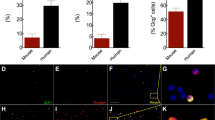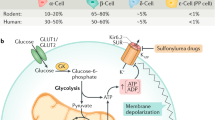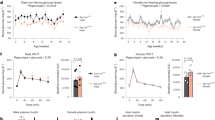Abstract
NON-INSULIN-DEPENDENT diabetes mellitus (NIDDM, type 2 diabetes) is a disorder of glucose homeostasis characterized by hyperglycaemia, peripheral insulin resistance, impaired hepatic glucose metabolism, and diminished glucose-dependent secretion of insulin from pancreatic β-cells1. Glucagon-like-peptide-1(7-37) (GLP-1)2 is an intestinally derived hormone that may be useful for the treatment of NIDDM because it acts in vivo to increase the level of circulating insulin, and thus lower the concentration of blood glucose3,4. This therapeutic effect may result from the ability of GLP-1 to compensate for a defect in the glucose signalling pathway that regulates insulin secretion from β-cells. In support of this concept we report here that GLP-1 confers glucose sensitivity to glucose-resistant p-cells, a phenomenon we term glucose competence. Induction of glucose competence by GLP-1 results from its synergistic interaction with glucose to inhibit metabolically regulated potassium channels that are also targeted for inhibition by sulphonylurea drugs commonly used in the treatment of NIDDM5. Glucose competence allows membrane depolarization, the generation of action potentials, and Ca2+ influx, events that are known to trigger insulin secretion6,7.
This is a preview of subscription content, access via your institution
Access options
Subscribe to this journal
Receive 51 print issues and online access
$199.00 per year
only $3.90 per issue
Buy this article
- Purchase on Springer Link
- Instant access to full article PDF
Prices may be subject to local taxes which are calculated during checkout
Similar content being viewed by others
References
Unger R. H. & Foster, D. W. in Williams Textbook of Endocrinology (eds Wilson, J. D. & Foster, D. W.) 1255–1333 (Saunders, Philadelphia, 1992).
Mojsov, S. et al. J. biol. Chem. 261, 11880–11889 (1986).
Nathan, D. M., Schreiber, E., Fogel, H., Mojsov, S. & Habener, J. F. Diabetes Care 15, 270–276 (1992).
Gutniak, M., Orskov, C., Hoist, J. J., Ahren, B. & Efendic, S. New Eng. J. Med. 326, 1316–1322 (1992).
Gerich, J. E. New Engl. J. Med. 321, 1231–1245 (1989).
Ashcroft, F. M. & Rorsman, P. Prog. Biophys. molec. Biol. 54, 87–143 (1991).
Rajan, A. S. et al. Diabetes Care 13, 340–363 (1990).
Drucker, D. J., Philippe, J., Mojsov, S., Chick, W. L. & Habener, J. F. Proc. natn. Acad. Sci. U.S.A. 84, 3434–3438 (1987).
Mojsov, S., Weir, G. C. & Habener, J. F. J. clin. Invest. 79, 616–619 (1987).
Fehmann, H. C. & Habener, J. F. Endocrinology 130, 159–166 (1992).
Weir, G. C., Mojsov, S., Hendrick, G. K. & Habener, J. F. Diabetes 38, 338–342 (1989).
Horn, R. & Marty, A. J. gen. Physiol. 92, 145–159 (1988).
Falke, L. C., Gillis, K. D., Pressel, D. M. & Misler, S. FEBS Lett. 251, 167–172 (1989).
Smith, P. A., Ashcroft, F. M. & Rorsman, P. FEBS Lett. 261, 187–190 (1990).
Hamill, O. P., Marty, A., Neher, E., Sakman, B. & Sigworth, F. Pflügers Arch. 391, 85–100 (1981).
Hiriart, M. & Matteson, D. R. J. gen. Physiol. 91, 617–639 (1988).
Pipeleers, D., In't Veld, P., Maes, E. & Van De Winkel, M. Proc. natn. Acad. Sci. U.S.A. 79, 7322–7325 (1982).
Sherman, A., Rinzel, J. & Keizer, J. Biophys. J. 54, 411–425 (1988).
Wang, J., Baimbridge, K. G. & Brown, J. C. Endocrinology 131, 146–152 (1992).
Ashcroft, F. M. A. Rev. Neurosci. 11, 97–118 (1988).
Blackmore, P. F., Mojsov, S., Exton, J. H. & Habener, J. F. FEBS Lett. 283, 7–10 (1991).
Goke, R. & Conlon, J. M. J. Endocrinol. 116, 357–362 (1988).
Fehmann, H. C. & Habener, J. F. Endocrinology 128, 2880–2888 (1991).
Thorens, B. Proc. natn. Acad. Sci. U.S.A. 89, 8641–8645 (1992).
Henquin, J. C. & Meissner, H. P. Endocrinology 115, 1125–1134 (1984).
Eddlestone, G. T., Oldham, S. B., Lipson, L. G., Premdas, F. H., & Beigelman, P. M. Am. J. Physiol. 248, C145–C153 (1985).
Smith, P. A., Rorsman, P. & Ashcroft, F. M. Nature 342, 550–553 (1989).
Prenkti, M., Glennon, M. C., Geschwind, J. F., Matschinsky, F. M. & Corkey, B. E. FEBS Lett. 220, 103–107 (1987).
Rajan, A. S., Hill, R. S. & Boyd, A. E. Diabetes 38, 874–880 (1989).
Ribalet, B., Ciani, S. & Edelstone, G. T. J. gen. Physiol. 94, 693–717 (1989).
Nichols, C. G. & Lederer, W. J. J. gen. Physiol. 97, 1095–1098 (1991).
Wang, W. & Giebisch, G. Proc. natn. Acad. Sci. U.S.A. 88, 9722–9725 (1991).
Author information
Authors and Affiliations
Rights and permissions
About this article
Cite this article
Holz IV, G., Kiihtreiber, W. & Habener, J. Pancreatic beta-cells are rendered glucose-competent by the insulinotropic hormone glucagon-like peptide-1(7-37). Nature 361, 362–365 (1993). https://doi.org/10.1038/361362a0
Received:
Accepted:
Issue Date:
DOI: https://doi.org/10.1038/361362a0
This article is cited by
-
Beyond glycemia: Comparing tirzepatide to GLP-1 analogues
Reviews in Endocrine and Metabolic Disorders (2023)
-
Gut microbiota in human metabolic health and disease
Nature Reviews Microbiology (2021)
-
Insulin secretion decline in Walker-256 tumor-bearing rats is early, follows the course of cachexia, and is not improved by lixisenatide
Naunyn-Schmiedeberg's Archives of Pharmacology (2021)
-
Therapeutic potential of α7 nicotinic acetylcholine receptor agonists to combat obesity, diabetes, and inflammation
Reviews in Endocrine and Metabolic Disorders (2020)
-
GLP-I secretion in healthy and diabetic Wistar rats in response to aqueous extract of Momordica charantia
BMC Complementary and Alternative Medicine (2018)
Comments
By submitting a comment you agree to abide by our Terms and Community Guidelines. If you find something abusive or that does not comply with our terms or guidelines please flag it as inappropriate.



